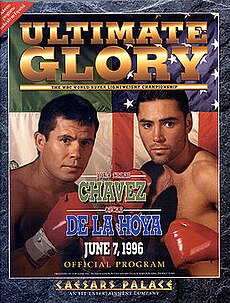Julio César Chávez vs. Oscar De La Hoya
 | |||||||||||||||||||||||||||||||
| Date | June 7, 1996 | ||||||||||||||||||||||||||||||
|---|---|---|---|---|---|---|---|---|---|---|---|---|---|---|---|---|---|---|---|---|---|---|---|---|---|---|---|---|---|---|---|
| Venue | Caesars Palace, Paradise, Nevada, U.S. | ||||||||||||||||||||||||||||||
| Title(s) on the line | WBC super lightweight title | ||||||||||||||||||||||||||||||
| Tale of the tape | |||||||||||||||||||||||||||||||
| |||||||||||||||||||||||||||||||
| Result | |||||||||||||||||||||||||||||||
| De La Hoya wins via 4th-round TKO | |||||||||||||||||||||||||||||||
Julio César Chávez vs. Oscar De La Hoya, billed as Ultimate Glory, was a professional boxing match contested on June 7, 1996, for the WBC super lightweight championship.[1]
Background
After both Julio César Chávez and Oscar De La Hoya defeated their opponents (Scott Walker and Darryl Tyson respectively) in tune-up bouts on February 9, 1996, the two fighters agreed to face one another in a "dream match" set for June of that year. The undefeated De La Hoya had already won world titles in two divisions and was looking to capture a second major world title (third in total) in a third weight class at only 23–years old. The 33–year old Chavez, meanwhile, was entering his 100th fight and still possessed one of the most impressive records in boxing history, having gone 97–1–1 and capturing four world titles in three divisions in his 16–year career.[2] The bout was highly anticipated, with some even calling the biggest fight in Latino boxing history and both fighters taking home a then–career high $9 million purse.[3] Despite his vast experience advantage over De La Hoya (who had only fought professionally 21 times up to that point) and his status as champion, the aging Chavez was initially installed as a 3–1 underdog before odds were dropped to 2–1 by the time of the fight. Though both fighters were of Mexican heritage, most Mexican and Mexican–American fans favored Chavez as De La Hoya had been born in the United States. In promotional stops for their fight, De La Hoya was largely booed by the largely Hispanic populations of Phoenix, San Diego and even his native Los Angeles.[4]
A controversial decision was made prior to the fight as De La Hoya's promoter Bob Arum refused to let the fight be carried on Pay-per-view and instead opted for it to be shown almost exclusively on closed-circuit television, severely limiting the highly anticipated bouts audience. Arum claimed that he made the decision to combat the use of illegal "black boxes", which steal pay-per-view signals and allow its users to watch the program for free. Though Arum claimed that the fight would net somewhere between $60 and $90 million even without pay-per-view, the fight drew a somewhat disappointing crowd of 750,000, down from the 1.7 million fans Arum had expected, and fell well short of his expected earnings, with the fight grossing around $14 million.[5][6]
The fight
The fight lasted less than four rounds. Only one minute into round one, De La Hoya connected with a straight right hand that opened up a huge gash around Chavez' eye. The fight was temporally halted not even a minute later as the cut had become severe enough for the referee Joe Cortez to stop the action and allow the fight doctor, Flip Homansky, to examine it. Though Chavez was able to continue, he was unable to get any momentum and was dominated by De La Hoya for the remainder of the fight. In round four, as Chavez was finally mounting some offense, De La Hoya took control of the latter stages of the round and brutalized Chavez with a series of hard combinations and broke Chavez' nose with a left hook. As the cut around his eye had deteriorated even further, Cortez halted the fight once again and sent him to the ringside physician. Homansky then informed Cortez that Chavez could not continue due to the multiple lacerations to his face and De La Hoya was awarded with the TKO victory at 2:37 of the fourth round.[7]
Aftermath
The fighters would meet two years later, in September 1998, with De La Hoya winning when Chavez retired in the eighth round.
Undercard
Confirmed bouts:[8]
Broadcasting
| Country | Broadcaster |
|---|---|
| Sky Sports | |
| HBO |
References
- ^ "Julio Cesar Chavez vs. Oscar De La Hoya (1st meeting)". boxrec.com. BoxRec. Retrieved 1 October 2024.
- ^ De La Hoya and Chavez Pave the Way to a Payday, N.Y. Times article, 1996-02-10, Retrieved on 2015-02-23
- ^ Chavez Has Title, De La Hoya Has It All, L.A. Times article, 1996-06-07, Retrieved on 2015-02-23
- ^ Chavez-De La Hoya Fight Is A Bout About Contrasts, Chicago Tribune article, 1996-06-07, Retrieved on 2015-02-23
- ^ Pugilistic Throwback: A Closed-Circuit Fight, N.Y. Times article, 1996-06-07, Retrieved on 2015-02-23
- ^ CHAVEZ-OSCAR: THE PPV BLOCKBUSTER THAT NEVER WAS, f4wonline.com article, 2009-09-04, Retrieved on 2015-02-23
- ^ De La Hoya Stops Bloodied Chavez in Four, N.Y. Times article, 1996-06-08, Retrieved on 2015-02-23
- ^ "BoxRec - event".
